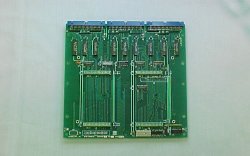 |
| |
Products
Since our founding in 1980, MICRODESIGNS has developed a number
of unique OEM and end-user products for Global Positioning System
(GPS),
Panasonic TLD Reader accessory and industrial microcomputer board and
system
applications. Most of these products were designed to meet requirements
that could not be economically met by any other commercial solution at
the time.
Click on the following links for descriptions and photos of
our products.
Note that information on discontinued products is generally provided
for
reference purposes only, although small quantities of some products may
still be available. For datasheets and other information, please contact
us.
QwikFlash Development Kits
and Accessories
- MICRODESIGNS is pleased to be working with Dr. John Peatman of
Georgia
Tech by offering assembled QwikFlash development boards and accessories
which can be used in an upper-level university lab or class in support
of his newest textbook Embedded Design with the PIC18F452
Microcontroller
Global Position System (GPS) Receivers for in-vehicle mobile and rackmount base station applications
GPS-100 Mobile GPS Receiver (G8 Sensor) (discontinued)
GPS-101 Mobile GPS Receiver (A12 Sensor) (discontinued)
GPS-102 Mobile GPS Receiver (B12 Sensor) (discontinued)
GPS-103 Mobile GPS Receiver (AC12 Sensor) (discontinued)
GPS-200 Reference Receiver (discontinued)
Panasonic Thermoluminescent Dosimetry (TLD) Reader Accessories
- MICRODESIGNS has been developing and refining glow-curve acquisition
technology since 1984 and has the largest installed base of
Panasonic-compatible
glow-curve products and accessories in the world
GCI/1 Glow-Curve Interface (discontinued)
GCI/2 Glow-Curve Interface
GCI/3 Glow-Curve Interface
TCA/1 Thermal Curve Adapter
LMP-7900 Lamp Bias Control
Industrial Single-Board Computer Expansion (SBX) boards
conforming
to the IEEE-959 standard for SBX I/O modules
uDX-221 Multifunction Multimodule (Dual Serial I/O, Clock/Calendar and CMOS RAM)
uDX-241 Clock and Quad Serial Multimodule
uDX-342 Quad Serial Multimodule
uDX-488 GPIB (IEEE-488) Multimodule
uDX-548 Buffered 48-line/Centronics Multimodule
uDX-549 Bit-Programmable Multimodule
Industrial Single-Board Computers/Cabinets -
software-compatible
with Intel Multibus-I 8085 and 8086 single-board computers as well as
original
designs
Multiboard-85/Multibox-85 (discontinued)
Multiboard-86/Multibox-86 (discontinued)
Multiboard-88/Expansion board
Multiboard-535
Global Positioning System (GPS) Receivers
The MICRODESIGNS series of GPS Receivers are designed around OEM GPS engines manufactured by Magellan Navigation. Formerly marketed under the Ashtech® and Magellan brands, these GPS engines are the core of our family of products that may be used to evaluate GPS for your application or as end-user products in their own right.GPS-100 Mobile GPS Receiver (G8 Sensor) (discontinued)
An inexpensive 8-channel receiver designed for mobile application. Built around the now-discontinued Ashtech® G8 GPS engine, the GPS-100 provides a rugged enclosure, an RS-232 interface, status display and power conditioning for demanding mobile environments. This product has been superseded by the GPS-101.GPS-101 Mobile GPS Receiver (A12 Sensor) (discontinued)
An inexpensive 12-channel receiver designed for mobile application. Built around the Magellan Navigation A12 GPS engine, the GPS-101 provides a rugged enclosure, an RS-232 interface, status display and power conditioning for demanding mobile environments. The GPS-101 is the replacement for the discontinued GPS-100. Manufactured for Magellan Navigation by MICRODESIGNS, A12 Sensor details and a PDF-format datasheet may be found here.GPS-102 Mobile GPS Receiver (B12 Sensor) (discontinued)
An inexpensive 12-channel receiver designed for mobile application. Built around the Magellan Navigation B12 GPS engine, the GPS-102 provides a rugged enclosure, an RS-232 interface, status display and power conditioning for demanding mobile environments.GPS-103 Mobile GPS Receiver (AC12 Sensor) (discontinued)
An inexpensive 12-channel receiver designed for mobile application and featuring raw GPS carrier phase measurements. Built around the new Magellan Navigation AC12 GPS engine, the GPS-103 provides a rugged enclosure, an RS-232 interface, status display and power conditioning for demanding mobile environments. Manufactured for Magellan Navigation by MICRODESIGNS, AC12 Sensor details and a PDF-format datasheet may be found here.GPS-200 Reference Receiver (discontinued)
This sophisticated 12-channel receiver is based on the powerful Magellan Navigation G12 GPS engine and is intended to be used as the position reference receiver in an automated vehicle location (AVL) system, providing location correction data to increase the accuracy of positions reported by mobile vehicles. The GPS-200 is provided in a 1U rack mount enclosure for use in 19" system racks.Panasonic Thermoluminescent Dosimetry (TLD) Reader Accessories
The MICRODESIGNS series of Glow-Curve Interfaces acquire detailed information about the radiation dose read from a Thermoluminescent Dosimetery badge by a Panasonic TLD badge reader. The GCI digitizes phosphor glow-curve and timing data and saves the reader's measurement string for analysis and long-term storage by a host computer. Programmed using English-like command mnemonics, our GCIs are supported by third-party software vendors, managing glow-curve data as port of a complete personnel dose data managment package.GCI/1 Glow Curve Interface (discontinued)
Real-time data acquisition system in a 19" rackmount cabinet for Panasonic UD-710A Thermoluminescent Dosimeter (TLD) Readers. The GCI/1 provides glow curve, timing and dosage information from the TLD reader to a host computer via a GPIB (IEEE-488) interface.GCI/2 Glow Curve Interface
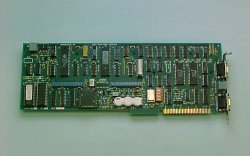 The
GCI/2 operates with Panasonic UD-710A and UD-716AGL automatic TLD
readers
along with the UD-702E, UD-705 and UD-706A manual readers and is our
most
economical solution to glow-curve acquisition requirements.
Functionally
similar to the GCI/1, the GCI/2 is a compact single-board GCI which is
installed in an ISA/EISA-compatible PC/AT, 386, 486, or Pentium
personal
computer host. A detached indicator pod provides GCI status
information.
Information is transferred between the GCI/2 and the host via the
host's
internal ISA backplane bus. The GCI/2 is suitable for PCs running
Windows
95/98/ME or MS-DOS only; use a GCI/3 for PCs operating under
Windows NT, Windows 2000 or Windows XP.
The
GCI/2 operates with Panasonic UD-710A and UD-716AGL automatic TLD
readers
along with the UD-702E, UD-705 and UD-706A manual readers and is our
most
economical solution to glow-curve acquisition requirements.
Functionally
similar to the GCI/1, the GCI/2 is a compact single-board GCI which is
installed in an ISA/EISA-compatible PC/AT, 386, 486, or Pentium
personal
computer host. A detached indicator pod provides GCI status
information.
Information is transferred between the GCI/2 and the host via the
host's
internal ISA backplane bus. The GCI/2 is suitable for PCs running
Windows
95/98/ME or MS-DOS only; use a GCI/3 for PCs operating under
Windows NT, Windows 2000 or Windows XP. GCI/3 Glow Curve Interface
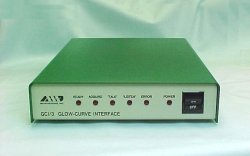 Functionally
identical to the GCI/2, the GCI/3 is a glow-curve capture device in a
small
stand-alone desktop cabinet which communicates to a host computer via
an
RS-232C serial interface. Because it is self-contained and uses the
industry-standard
RS-232C serial interface, the GCI/3 can be easily interfaced to a wide
array of computers and operating systems. Dosimetry management systems
which use PCs, workstations, or notebook computers as hosts are
candidates for the GCI/3.
Functionally
identical to the GCI/2, the GCI/3 is a glow-curve capture device in a
small
stand-alone desktop cabinet which communicates to a host computer via
an
RS-232C serial interface. Because it is self-contained and uses the
industry-standard
RS-232C serial interface, the GCI/3 can be easily interfaced to a wide
array of computers and operating systems. Dosimetry management systems
which use PCs, workstations, or notebook computers as hosts are
candidates for the GCI/3. TCA/1 Thermal Curve Adapter
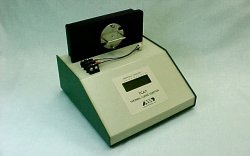 The
TCA/1 is an accessory fixture that allows direct measurement of the
badge
heating cycle in a Panasonic TLD reader. When used with a MICRODESIGNS
or Panasonic glow-curve interface, the digitized thermal curve
generated
by the TCA/1 may be observed on a host computer's graphics display,
analyzed
and stored for later reference. The TCA/1 displays the base and peak
temperatures
of an observed heating cycle on a four-line alpha-numeric LCD display,
allowing stand-alone use.
The
TCA/1 is an accessory fixture that allows direct measurement of the
badge
heating cycle in a Panasonic TLD reader. When used with a MICRODESIGNS
or Panasonic glow-curve interface, the digitized thermal curve
generated
by the TCA/1 may be observed on a host computer's graphics display,
analyzed
and stored for later reference. The TCA/1 displays the base and peak
temperatures
of an observed heating cycle on a four-line alpha-numeric LCD display,
allowing stand-alone use. LMP-7900 Lamp Bias Control
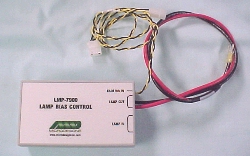 The
LMP-7900 Lamp Bias Control is a reader accessory that
manages the heating lamp bias current in Panasonic’s flagship UD-7900
TLD reader. Requiring only screwdrivers for installation, the LMP-7900
allows manual adjustment of the bias current and also permits
measurement of the lamp voltage and current waveforms by service
technicians.
The
LMP-7900 Lamp Bias Control is a reader accessory that
manages the heating lamp bias current in Panasonic’s flagship UD-7900
TLD reader. Requiring only screwdrivers for installation, the LMP-7900
allows manual adjustment of the bias current and also permits
measurement of the lamp voltage and current waveforms by service
technicians.The Panasonic UD-7900 TLD reader uses an advanced computer-controlled power supply to operate the heating lamp, which allows the UD-7900 to operate in UD-710A heating mode, UD-716AGL heating mode, or anywhere in between. However, an unfortunate side effect of the new technology is the loss of the lamp bias constant-current feature provided in those older Panasonic readers.
Installed between the lamp power supply and the UD-7900’s heating lamp, the LMP-7900 restores the missing lamp bias constant-current feature. The LMP-7900’s operation is simple: if the lamp voltage supplied by the reader is greater than 2.5 Volts (lamp “on”), then the LMP-7900 applies the full voltage to the lamp; if the lamp voltage is less than 2.5 Volts (lamp “off”), then the LMP-7900 switches to bias constant-current mode. The LMP-7900’s bias current level is set manually with an internal screwdriver control — similar to the adjustment in the UD-710A — and is factory-preset to a value of 2.0 Amps.
Industrial Single Board Computer Expansion (SBX) Boards
Intel developed the SBX Multimodule concept in the early 1980s as a method for easily expanding the on-board resources of industrial single-board computers. Intel allowed SBX to be an open architecture standard and encouraged their customers and competitors to design specialty I/O boards. Eventually becoming IEEE Standard 959, the SBX standard defines two PC board sizes: the "single wide" measuring 2.85 x 3.70 inches and the "double wide" measuring 2.85 x 7.50 inches; both sizes attach to the host board using a special locking connector and one or more nylon spacers with screws. Although not as widely used as they were in the 1980s and early 1990s, SBX modules continue to be used today in many legacy computer systems.uDX-221 Multifunction Multimodule (Dual Serial, Clock/Calendar and CMOS RAM)
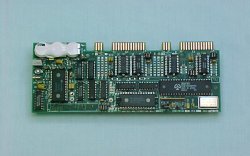 An
SBX board providing two independent RS-232C or RS-422A/449 serial ports
with individually programmable baud rates; a battery-maintained
clock/calendar
with programmable periodic, time-of-day alarm and power fail
interrupts;
and 8K, 32K or 128K bytes of battery-maintained CMOS RAM. Available in
mixed TTL/MOS/CMOS logic or all-CMOS for low operating power
applications.
Double-wide SBX module.
An
SBX board providing two independent RS-232C or RS-422A/449 serial ports
with individually programmable baud rates; a battery-maintained
clock/calendar
with programmable periodic, time-of-day alarm and power fail
interrupts;
and 8K, 32K or 128K bytes of battery-maintained CMOS RAM. Available in
mixed TTL/MOS/CMOS logic or all-CMOS for low operating power
applications.
Double-wide SBX module. uDX-241 Clock and Quad Serial Multimodule
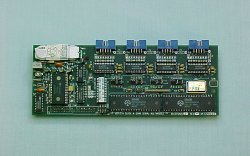 The
MICRODESIGNS uDX-241 Clock and Quad Serial Multimodule contains
circuitry
for a battery-maintained real-time Clock/Calendar and four independent
RS-232C or RS-422A/485 multi-protocol serial I/O channels on a
dual-width
SBX expansion board. Each channel may be individually configured for
synchronous
or asynchronous operation, baud rate, and RS-232C or RS-422A electrical
interface. The uDX-241 attaches directly to any SBX-compatible host
board
which supports a double-wide module, and is available in mixed
TTL/MOS/CMOS
logic or all-CMOS for low operating power applications.
The
MICRODESIGNS uDX-241 Clock and Quad Serial Multimodule contains
circuitry
for a battery-maintained real-time Clock/Calendar and four independent
RS-232C or RS-422A/485 multi-protocol serial I/O channels on a
dual-width
SBX expansion board. Each channel may be individually configured for
synchronous
or asynchronous operation, baud rate, and RS-232C or RS-422A electrical
interface. The uDX-241 attaches directly to any SBX-compatible host
board
which supports a double-wide module, and is available in mixed
TTL/MOS/CMOS
logic or all-CMOS for low operating power applications. uDX-342 Quad Serial Multimodule
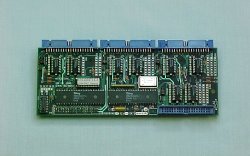 An
SBX board providing four independent RS-232C or RS-422A/449 serial
ports
with individually programmable baud rates. Available in mixed
TTL/MOS/CMOS
logic or all-CMOS for low operating power applications. Your choice of
8080/85 or 8086/88 software drivers is included. Double-wide SBX
module.
An
SBX board providing four independent RS-232C or RS-422A/449 serial
ports
with individually programmable baud rates. Available in mixed
TTL/MOS/CMOS
logic or all-CMOS for low operating power applications. Your choice of
8080/85 or 8086/88 software drivers is included. Double-wide SBX
module. uDX-488 GPIB (IEEE-488) Multimodule
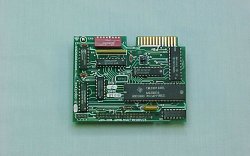 An
SBX IEEE-488 (GPIB, HPIB) interface providing talker, listener and
controller
functions using the industry-standard Texas Instruments TMS-9914A GPIB
controller chip set. Provides full GPIB capability, including proper
DMA
operation. A GPIB-compatible flat cable with metric hardware and your
choice
of 8080/85 or 8086/88 software driver is included. Single-wide SBX
module.
An
SBX IEEE-488 (GPIB, HPIB) interface providing talker, listener and
controller
functions using the industry-standard Texas Instruments TMS-9914A GPIB
controller chip set. Provides full GPIB capability, including proper
DMA
operation. A GPIB-compatible flat cable with metric hardware and your
choice
of 8080/85 or 8086/88 software driver is included. Single-wide SBX
module. uDX-548 Buffered 48-line/Centronics Multimodule
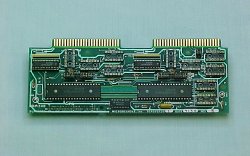 A
fully buffered 48-line parallel I/O SBX board which provides twice the
capacity of the industry-standard SBX-350 while maintaining connector
and
functional compatibility. The uDX-548 makes parallel printer
interfacing
particularly easy through pre-wired sockets and a simple
interconnecting
cable. Double-wide SBX module.
A
fully buffered 48-line parallel I/O SBX board which provides twice the
capacity of the industry-standard SBX-350 while maintaining connector
and
functional compatibility. The uDX-548 makes parallel printer
interfacing
particularly easy through pre-wired sockets and a simple
interconnecting
cable. Double-wide SBX module. uDX-549 Bit-Programmable Multimodule
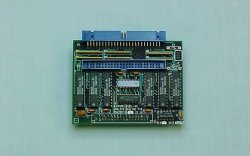 The
MICRODESIGNS uDX-549 provides 48 bit-programmable lines of buffered
TTL-compatible
parallel I/O on a single-wide SBX board. Each line is individually
software
programmable as an input or output, so the user is not required to
configure
lines in groups of 4 or 8 input/outputs. Each line is terminated with a
1.0 KOhm pull-up resistor, and, when configure as an output, is an
open-collector
TTL driver capable of sinking 24 milliamperes. The uDX-549's two 50-pin
I/O connectors are compatible with OPTO-22-type industrial interface
racks
and modules. To ease software programming, previously written output
values
can be read back. The uDX-549 improves on competitive SBX modules by
offering
twice as many parallel lines, I/O direction bit-programmability, and
high
current TTL buffering while retaining a single-wide SBX board form
factor.
The
MICRODESIGNS uDX-549 provides 48 bit-programmable lines of buffered
TTL-compatible
parallel I/O on a single-wide SBX board. Each line is individually
software
programmable as an input or output, so the user is not required to
configure
lines in groups of 4 or 8 input/outputs. Each line is terminated with a
1.0 KOhm pull-up resistor, and, when configure as an output, is an
open-collector
TTL driver capable of sinking 24 milliamperes. The uDX-549's two 50-pin
I/O connectors are compatible with OPTO-22-type industrial interface
racks
and modules. To ease software programming, previously written output
values
can be read back. The uDX-549 improves on competitive SBX modules by
offering
twice as many parallel lines, I/O direction bit-programmability, and
high
current TTL buffering while retaining a single-wide SBX board form
factor. Industrial Single Board Computers/Cabinets
Multiboard-85/Multibox-85 (discontinued)
An industrially packaged 8085-based single board computer system providing all features of Intel's iSBC-80/24 (ROM, RAM, parallel I/O, RS-232C serial I/O, interrupt controller, counter/timer) plus the following enhancements: added EPROM and RAM capacity, prototype area, RAM is battery-maintained CMOS, packaged with power supply in a 3½" rack-mountable cabinet. A very economical package for small micro-based systems.Multiboard-86/Multibox-86 (discontinued)
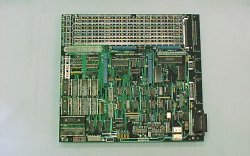 Software-compatible
with Intel's iSBC-86/14 Multibus-I single-board computer, Multiboard-86
is an industrially packaged 8 MHz zero-wait-state 8086-based single
board
computer that provides up to 256K bytes of EPROM, up to 128K bytes of
battery-maintained
CMOS RAM, an optional math coprocessor, RS-232C serial I/O, parallel
I/O,
counter timers, 4 SBX sites and a prototype area. Available packaged in
a 3½" rack-mountable cabinet with power supply. A powerful
full-featured
industrial computer for dedicated applications.
Software-compatible
with Intel's iSBC-86/14 Multibus-I single-board computer, Multiboard-86
is an industrially packaged 8 MHz zero-wait-state 8086-based single
board
computer that provides up to 256K bytes of EPROM, up to 128K bytes of
battery-maintained
CMOS RAM, an optional math coprocessor, RS-232C serial I/O, parallel
I/O,
counter timers, 4 SBX sites and a prototype area. Available packaged in
a 3½" rack-mountable cabinet with power supply. A powerful
full-featured
industrial computer for dedicated applications. Multiboard-88/Expansion Board
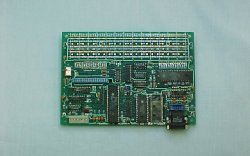 A
compact 6 MHz zero-wait-state 8088-based single board computer
providing
up to 128K bytes of EPROM, up to 128K bytes of RAM, RS-232C serial I/O,
parallel I/O, counter timers, one SBX site and a prototype area.
Excellent
CPU for embedding in intelligent instruments or for use in distributed
control applications. An expansion board available which provides up to
72 lines of bit-configurable parallel I/O and additional SBX expansion
sites (up to four single-wide or two double-wide).
A
compact 6 MHz zero-wait-state 8088-based single board computer
providing
up to 128K bytes of EPROM, up to 128K bytes of RAM, RS-232C serial I/O,
parallel I/O, counter timers, one SBX site and a prototype area.
Excellent
CPU for embedding in intelligent instruments or for use in distributed
control applications. An expansion board available which provides up to
72 lines of bit-configurable parallel I/O and additional SBX expansion
sites (up to four single-wide or two double-wide). Multiboard-535
A compact 12 MHz 80C535-based single board computer providing up to 64K bytes of EPROM, up to 32K bytes of RAM, up to 8K bytes of EEPROM, RS-232C serial I/O, parallel I/O, counter timers, an eight-input A/D converter, one SBX site, prototype area and on-board DC power supply. The 80C535 is a highly integrated superset of the 8051 family of single-chip microprocessors. Excellent internal CPU for intelligent instruments.
|
|
|
|
|
|
|
|
|
| MICRODESIGNS, Inc. 1979 S. Bibb Dr. Tucker, GA 30084 (770) 493-6318 (770) 493-7270 FAX |
